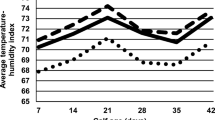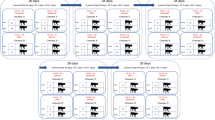Abstract
The objective of this paper was to evaluate the effects of high temperatures on calves. The hypothesis that the red and white blood cells, health, and performance of calves would be influenced by the temperature period at birth and gender was tested. Sixty-three Holstein calves were used. They were reared in individual hutches from the second day of life to weaning at the age of 8 weeks. All calves were allotted to treatment groups according to the temperature period at birth: moderate temperature period 1 (MT1), high temperature period (HT), moderate temperature period 2 (MT2). The same conditions of nutrition were ensured. We recorded 62 summer days and 14 tropical days during HT. Sixty-six days with a value above 72.0 of the temperature–humidity index (THI) and 26 with values greater than 78.0 were found. No significant differences were found in red blood cells with the exception of hemoglobin between MT1 and MT2 (p = 0.031) during the 8th week. Significant differences were observed among treatment groups in the percentage of eosinophiles during the 6th week (p = 0.044). The HT calves had the least body weight from the first week to weaning (p = 0.053) and the highest water consumption (p = 0.042). The results emphasize the ability of dairy calves to maintain homeostasis during prolonged periods of heat stress. The exposure to high temperatures resulted only in a significant decrease of starter concentrate consumption and reduced growth.

Similar content being viewed by others
References
Anonymous (2001) Statistix for Windows. Version 8.0. User’s Manual. Analytical Software, P.O.Box 12185, Tallahassee, FL 32317-2185, USA
Blackshaw JK, Blackshaw AW (1994) Heat stress in cattle and the effect of shade on production and behaviour. Aust J Exp Agric 34:285–295. doi:10.1071/EA9940285
Beatty DT, Barnes A, Taylor E, Pethick D, McCarthy M, Maloney SK (2006) Physiological responses of Bos taurus and Bos indicus cattle to prolonged, continuous heat and humidity. J Anim Sci 84:972–985
Bray DR, Bucklin RA, Shearer JK, Montoya R, Giesy R (1997) Reduction of environmental stress in adult and young dairy cattle in hot, humid climates. Proceedings of the Fifth International Symposium, Bloomington, Minnesota, May 29–31, Vol I, pp 672–679
Broucek J, Kovalcik K, Gajdosik D (1987) The effect of extreme ambient temperatures on the haematological and biochemical parameters of heifers. Vet Med 32:259–268
Broucek J, Novak L, Kovalcik K (1988) The effect of lower temperatures on growth and health condition calves housed in outdoor hutches and calf barn. Czech J Anim Sci 33:27–36
Broucek J, Kovalcik K (1989) Einfluss der übermässigen künstlichen UV - Strahlung auf die Messgrossen des Blutbildes und auf die Phagozytose bei Kälbern. Dtsch Tierarztl Wschr 96:318–320
Broucek J, Kovalcik K, Letkovicova M, Novak L (1990a) Evaluation of ethological parameters in calves kept in outdoor hutches. Czech J Anim Sci 35:301–310
Broucek J, Kovalcik K, Novak L (1990b) Evaluation of different types of hutches for calves on the basis of the ethological studies. Polnohospodarstvo 36:543–552
Broucek J, Arave CW, Kisac P, Mihina S, Flak P, Uhrincat M, Hanus A (2006) Effects of some management factors on milk production in first-calf heifers. Asian-australas J Anim Sci 19:672–678
Brown-Brandl TM, Nienaber JA, Eigenberg RA, Freetly HC, Hahn GL (2003) Thermoregulatory responses of feeder cattle. J Therm Biol 28:149–157. doi:10.1016/S0306-4565(02)00052-9
Brown-Brandl TM, Eigenberg RA, Nienaber JA, Hahn GL (2004) Indicators of heat stress in shaded and non-shaded feedlot cattle. ASAE/CSAE Annual International Meeting, Ottawa, Ontario, Canada, Paper No 044037
Carter BH, Friend TH, Matis JH, Sawyer JE, Tomaszewski MA (2008) Effect of reflective insulation on calves in polyethylene hutches. J Anim Sci Vol 86, E-Suppl 2/J Dairy Sci Vol 91. E-Suppl 1:327.
Coleman DA, Moss BR, McCaskey TA (1996) Supplemental shade for dairy calves reared in commercial calf hutches in a southern climate. J Dairy Sci 79:2038–2043
Davis CL, Drackley JK (1998) The development, nutrition, and management of the young calf. Iowa State University Press, Ames, Iowa
Du Prezz JH, Giesecke WH, Hattingh PJ (1990) Heat stress in dairy cattle and other livestock under southern African conditions. III. Monthly temperature-humidity index mean values and their significance in the performance of dairy cattle. Onderstepoort J Vet Res 57:243–248
Hahn GL, Mader TL (1997) Heat waves in relation to thermoregulation, feeding behavior and mortality of feedlot cattle. Proceedings of the Fifth International Symposium, Bloomington, Minnesota, May 29–31, Vol I, pp 563–571
Hoshiba S, Sato Y, Isobe S, Sone A, Okamoto M, Dohkoshi J (1985) Thermal environment in calf hutches. Japn J Livest Manage 20:101–107
Hoshiba S, Isobe S, Sato Y, Dohkoshi J, Sone A, Okamoto M (1988) Behavior of calves housed in calf hutches in summer of Hokkaido as influenced by the meteorological environment. Japn J Livest Manage 23:73–80
Hubbard KG, Stooksbury DE, Hahn GL, Mader TL (1999) A climatologic perspective on feedlot cattle performance and mortality related to the temperature-humidity index. J Prod Agric 12:650–653
Huber JT (1996) Amelioration of heat stress in dairy cattle. In: Philips CJC (ed) Progress in dairy Science. CAB International, Oxon, UK, pp 211–243
Illek J, Kudrna V, Matejicek M, Novak P, Slavik P (2007) Heat stress in dairy cows – health, production and reproduction. Our Herd Prague 67:63–65
Jagos P, Illek J, Doubek J (1985) Metabolic profile in beef bulls under conditions of industrial technologies. Acta Vet (Brno) 54:41–51
Johnson HD (1987) Bioclimate effects on growth, reproduction and milk production. In: Johnson HD (ed) Bioclimatology and the adaptation of livestock. World Animal Science, B5. Elsevier, Amsterdam, The Nederlands, pp 35–57
Larson LL, Owen FG, Albright JL (1977) Guidelines toward more uniformity in measuring and reporting calf experimental data. J Dairy Sci 60:989–991
Lacetera N, Bernabucci U, Scalia D, Ronchi B, Kuzminsky G, Nardone A (2005) Lymphocyte functions in dairy cows under hot environment. Int J Biometeorol 50:105–110. doi:10.1007/s00484-005-0273-3
Mader TL, Davis MS (2004) Effect of management strategies on reducing heat stress of feedlot cattle: feed and water intake. J Anim Sci 82:3077–3087
Mader TL, Dahlquist JM, Hahn GL, Gaughan JB (1999) Shade and wind barrier effects on summertime feedlot cattle performance. J Anim Sci 77:2065–2072
Mader TL, Davis MS, Brown-Brandl TM (2006) Environmental factors influencing heat stress in feedlot cattle. J Anim Sci 84:712–719
May J, Mannoiu I, Donta C (1977) Untersuchungen über die Wärmebelastung beim Kalb. Zbl Veter Med Reihe A 24:153–159
Meyer DJ, Harvey JW (2004) Veterinary laboratory medicine: iInterpretation and diagnosis, 3rd edn. Saunders, St. Louis
Mitloehner FM, Galyean ML, McGlone JJ (2002) Shade effects on performance, carcass traits, physiology, and behavior of heat-stressed feedlot heifers. J Anim Sci 80:2043–2050
Mohri M, Sharifi K, Eidi S (2007) Hematology and serum biochemistry of Holstein dairy calves: age related changes and comparison with blood composition in adults. Res Vet Sci 83:30–39. doi:10.1016/j.rvsc.2006.10.017
Nardone A, Lacetera N, Bernabucci U, Ronchi B (1997) Composition of colostrum from dairy heifers exposed to high air temperatures during late pregnancy and the early postpartum period. J Dairy Sci 80:838–844
Nardone A, Ronchi B, Lacetera N, Bernabucci U (2006) Climatic effects on productive traits in livestock. Vet Res Commun 30(Suppl. 1):75–81. doi:10.1007/s11259-006-0016-x
Nienaber JA, Hahn GL, Eigenberg RA (1999) Quantifying livestock responses for heat stress management: a review. Int J Biometeorol 42:183–188. doi:10.1007/s004840050103
Robertshaw D (2006) Mechanisms for the control of respiratory evaporative heat loss in panting animals. J Appl Physiol 101:664–668. doi:10.1152/japplphysiol.01380.2005
Schäffer D, von Borell E (2008) Kritische Kontrollpunkte (CCP) in der Außenhaltung von Kälbern. Züchtungskunde 80:291–302
Seifi HA, Mohri M, Shoorei E, Farzaneh N (2006) Using haematological and serum biochemical findings as prognostic indicators in calf diarrhoea. Comp Clin Pathol 15:143–147. doi:10.1007/s00580-006-0620-8
Singh SP, Newton WM (1978) Acclimation of young calves to high temperatures: physiologic responses. Am J Vet Res 39:795–797
Soch M, Novak P, Kratochvil P, Travnicek J (1999) Losses of water vapour in the relation to the stable climate factors in calves. Acta Hortic Regiotecturae Nitra Slovakia 2:179–181
Soch M (2005) Effect of environment on selected indices of cattle welfare. University of South Bohemia, Ceske Budejovice
Spain JN, Spiers DE (1994) Physiologival responses of young calves housed in hutches with or without supplemental shade during summer. Dairy Systems for the 21st Century. Proceedings of the Third International Dairy Housing Conference, 2–5 February 1994, Orlando, Florida, pp 781–789
Spain JN, Spiers DE (1996) Effects of supplemental shade of calves to heat challenge in on thermoregulatory response a hutch environment. J Dairy Sci 79:639–646
West JW (2003) Effects of heat-stress on production in dairy cattle. J Dairy Sci 86:2131–2144
Author information
Authors and Affiliations
Corresponding author
Rights and permissions
About this article
Cite this article
Broucek, J., Kisac, P. & Uhrincat, M. Effect of hot temperatures on the hematological parameters, health and performance of calves. Int J Biometeorol 53, 201–208 (2009). https://doi.org/10.1007/s00484-008-0204-1
Received:
Accepted:
Published:
Issue Date:
DOI: https://doi.org/10.1007/s00484-008-0204-1




